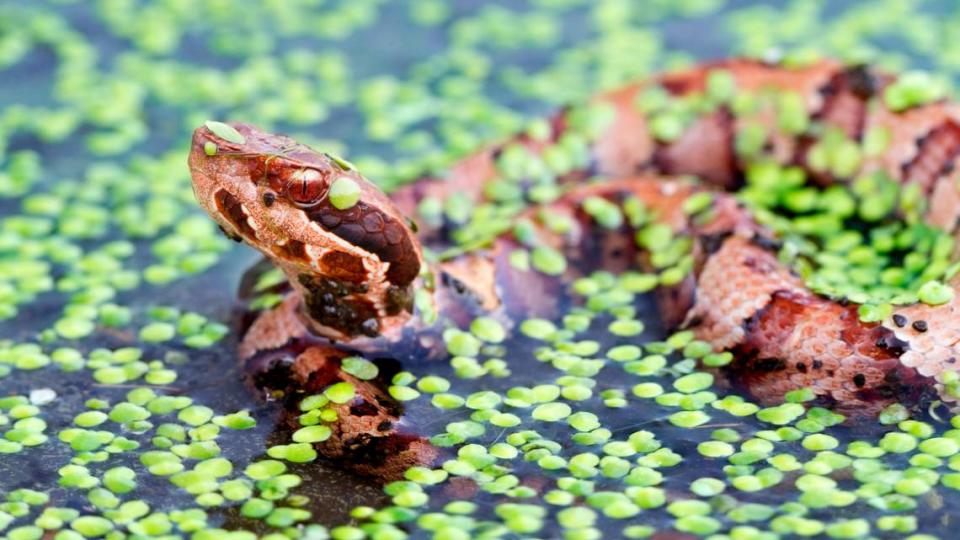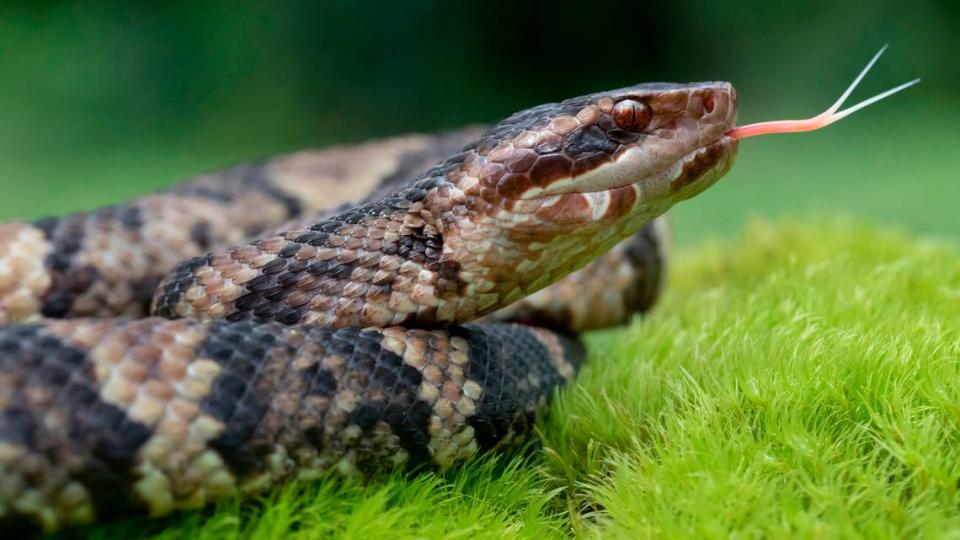How to identify (and avoid) NC’s venomous cottonmouth (aka water moccasin) snake
Cottonmouth snakes, also known as water moccasins, are another of our state’s six venomous snake species.
They’re cousins to copperheads, a venomous snake frequently seen throughout the Triangle.
Although cottonmouths are primarily found in the eastern part of the state, they can be spotted in Johnston County and easternmost parts of Wake County.
Though it’s unusual to see a cottonmouth in the Triangle, you should still know how to identify it and stay safe from a bite.
What does a cottonmouth snake look like?
The cottonmouth’s name-defining characteristic is its white (or very pale colored) mouth.
The snake’s mouth is a stark contrast to its darker colored, thick body. The snake gapes and reveals its pale mouth to defend itself, Kevin Bischof, a park superintendent with the N.C. Division of Parks and Recreation, told The N&O last year.

Cottonmouths are also heavier bodied, which can distinguish it from other nonvenomous water snakes, he said.
Here are some defining characteristics of cottonmouths, according to the NC Wildlife Resources Center:
They have facial pits for sensing infrared radiation (or heat).
Their heads are distinctly wider than their necks.
They have a dark bar on both sides of their heads that spans from the eyes to the angles of their jaws.
They have nine large scales on the crowns of their heads.
Their pupils are vertically elliptical.
They’re patterned with dark crossbands that have light olive or brown centers. The crossbands are widest on the sides of the snake and narrowest on the top. (Note: This is the opposite of most nonvenomous watersnakes that are often mistaken for cottonmouths.)
Young cottonmouths have bright green (sometimes yellowish) tail tips. The details of the cross band pattern are most evident when they’re young, while older cottonmouths can be completely dark and unpatterned.
They do not have rattles on the ends of their tails.
(Source: ncwildlife.org)
How severe are cottonmouth snake bites?
Cottonmouths are venomous snakes. Their bites can be severe, but they’re generally not as bad as other North Carolina snakes, especially rattlesnakes.
Generally, cottonmouth bites have about the same severity level as copperhead bites, according to NC Poison Control.
Here’s an excerpt from previous N&O reporting on copperhead bites:
Above all, show up for care: If you get bitten by a venomous snake (or you’re unsure if the snake that bit you is venomous), seek care.
If you have concerning symptoms, go straight to an emergency department. This can include:
Difficulty breathing
Chest pain
Dizziness
Significant swelling
“Any patient with worsening pain, swelling or any other concerning symptoms should be evaluated in person,” said Dr. Ben German, WakeMed emergency physician and medical professional with the international Asclepius Snakebite Foundation.
If you do not have these concerning symptoms, you can call NC Poison Control (1-800-222-1222) first. This is a free 24/7 hotline for people in North and South Carolina who want to speak with a medical expert before heading to the emergency room.
And to learn more about seeking medical care (and how to know if you need antivenom) for a copperhead bite, visit newsobserver.com/news.
Where are cottonmouth snakes located in NC?
Cottonmouths can be found on the eastern half of North Carolina.
“Distribution is the coastal plains to the sandhills. They don’t range into the Piedmont or the mountains,” said Jeff Hall, biologist and snake expert with the NC Wildlife Resources Commission.
“Even though every year I get emails from Durham, Raleigh, Asheville, Winston-Salem saying ‘I saw a cottonmouth on my property!’ Based on where your feet are on planet earth, you did not see a cottonmouth.”
Range maps published by NC Poison Control and NC Wildlife Resources Commission show their range including the eastern portion of Wake County and all of Johnston County. You won’t find a cottonmouth in Orange, Durham or Chatham counties.

Cottonmouth vs. non-venomous watersnake
Watersnakes are harmless to humans, as they don’t have fangs and venom glands.
“Identification for any snake species comes down to familiarity, and the more familiar you are with snakes in your area, the better you can know which snakes are there and not there,” Hall said.
“Several water snake species look a lot like a cottonmouth, and it can be difficult to tell at a quick glance — especially while your heart rate is spiking because you just saw a snake. … If you start to learn some things, you can tell some good differences between cottonmouths and other watersnakes, like the common banded water snake.”
There are at least 10 things to look for that can help you differentiate between the two snakes. Here are characteristics of watersnakes, according to the NC Wildlife Resources Commission:
Watersnakes…
don’t have heat-sensing facial pits that vipers do.
have two rows of scales underneath the tail (cottonmouths have one).
have the widest part of the dark crossbands on their backs.
have narrower heads (though they can be flattened to appear larger).
lack yellow tail tips when they’re young.
have boldly striped upper lips (while cottonmouths have plain ones).
have round pupils (while cottonmouths have vertically elliptical ones).
do not gape their mouths.
will dive beneath water to escape predators (while cottonmouths swim across the surface).
occur statewide, not just in the coastal plain areas of the state.
(Source: ncwildlife.org)
“There’s a myth that cottonmouths don’t swim underwater, so they won’t bite you underwater. If you’re out swimming, I can say a cottonmouth will not swim under the water to bite you, but they absolutely can,” Hall said.
“They’re generalists who eat a lot of different species, including fish. And it’s difficult to eat a fish if you don’t swim underwater, so they can absolutely do that.”

How to avoid a cottonmouth snake bite
Give the snake space. Snakes rarely, if ever, bite unprovoked.
“There’s no reason to interact with an animal, and that’s when you get into problems. Animals get defensive trying to protect themselves,” Hall said.
“If you leave snakes alone, give them wide berths and especially avoid touching them, you are much more likely to have positive snake encounters.”
There are some other precautions to take during NC’s snake season to avoid bites. Here’s what NC Poison Control says to do:
Watch your step, and watch where your hands go. Don’t reach where you can’t see, and don’t step over an object without knowing what is on the other side.
Wear sturdy boots or shoes when you’re outside, especially when gardening or hiking.
Wear gloves when gardening.
Use a flashlight at night when you’re outside, even when you know the area well.
Back away slowly if you see a snake. Don’t try to pick it up or kill it. It can bite you while you’re trying to grab it. A dead snake, or even the detached head of a snake, can still bite because of the bite reflex.
(Source: cdn.atriumhealth.org)
Is that a copperhead? No, it’s more likely one of these non-venomous NC snakes
How do you treat a copperhead snake bite? Duke and WakeMed doctors walk us through
Bitten by a copperhead? You may need antivenom. Here’s how much that costs in NC


